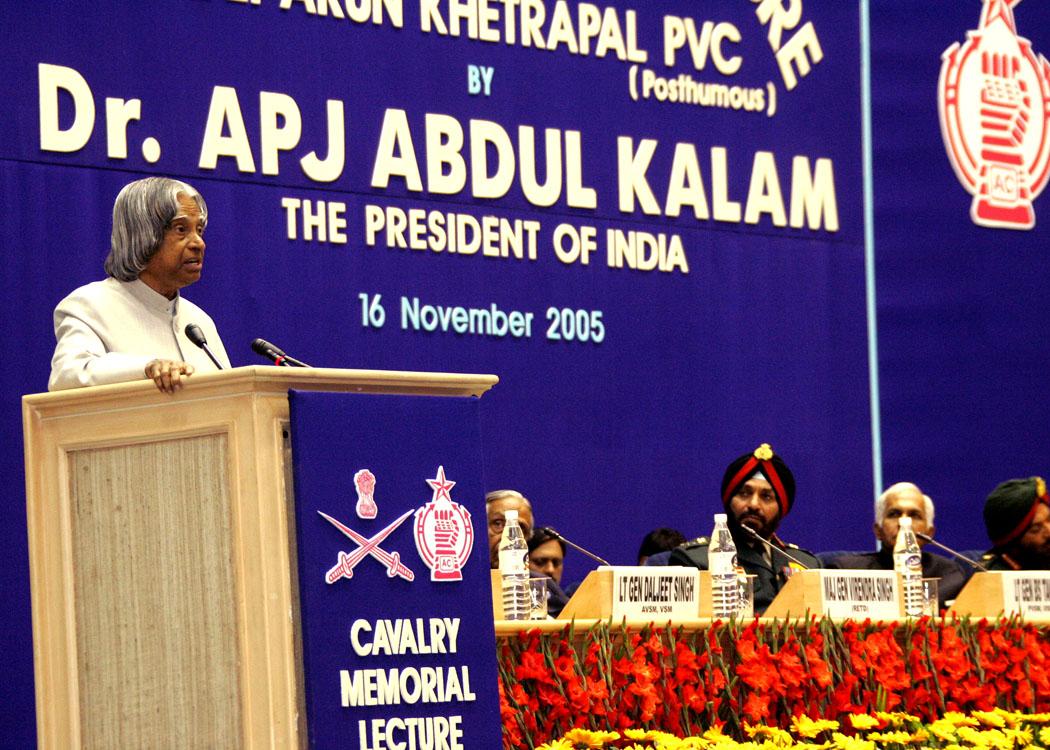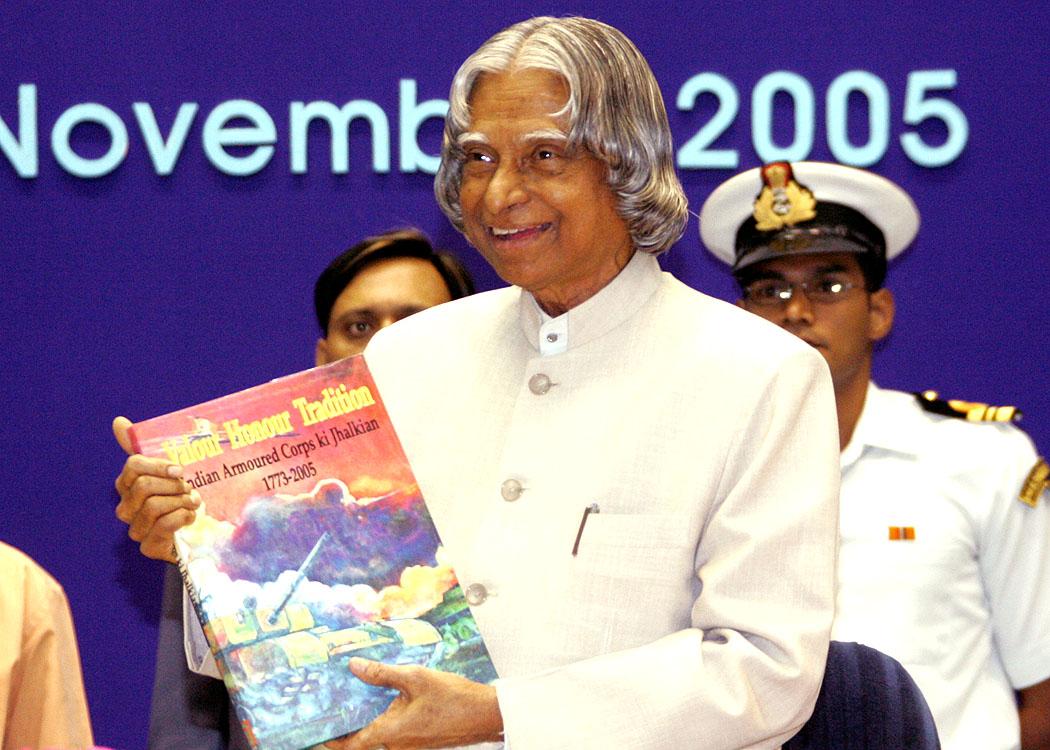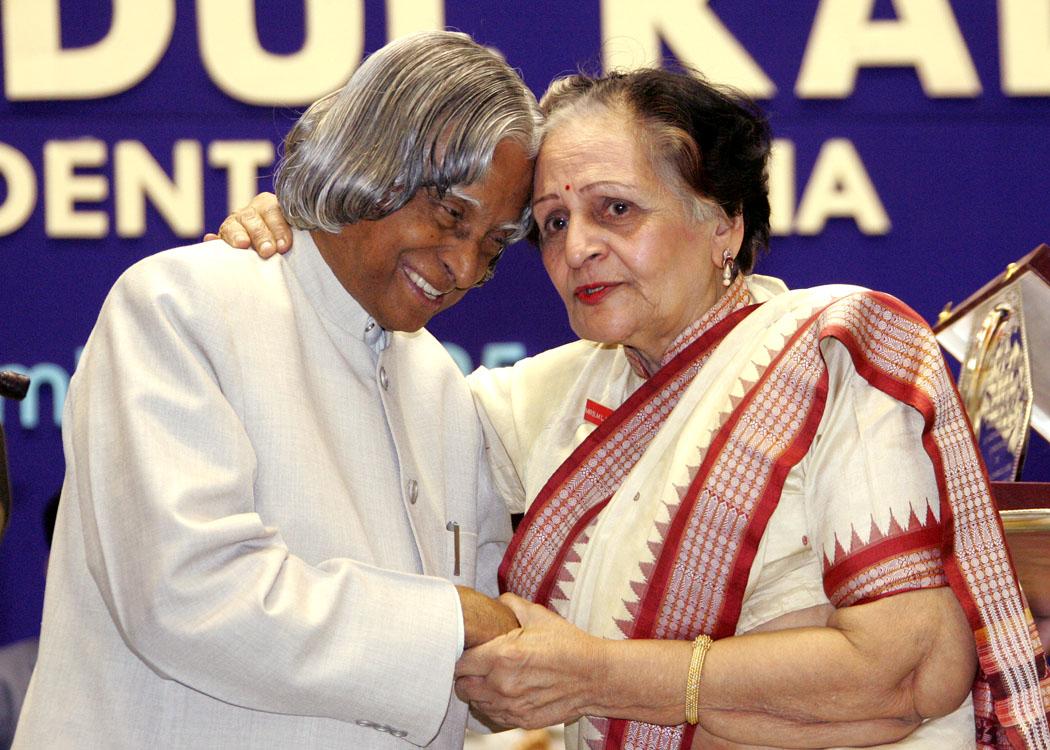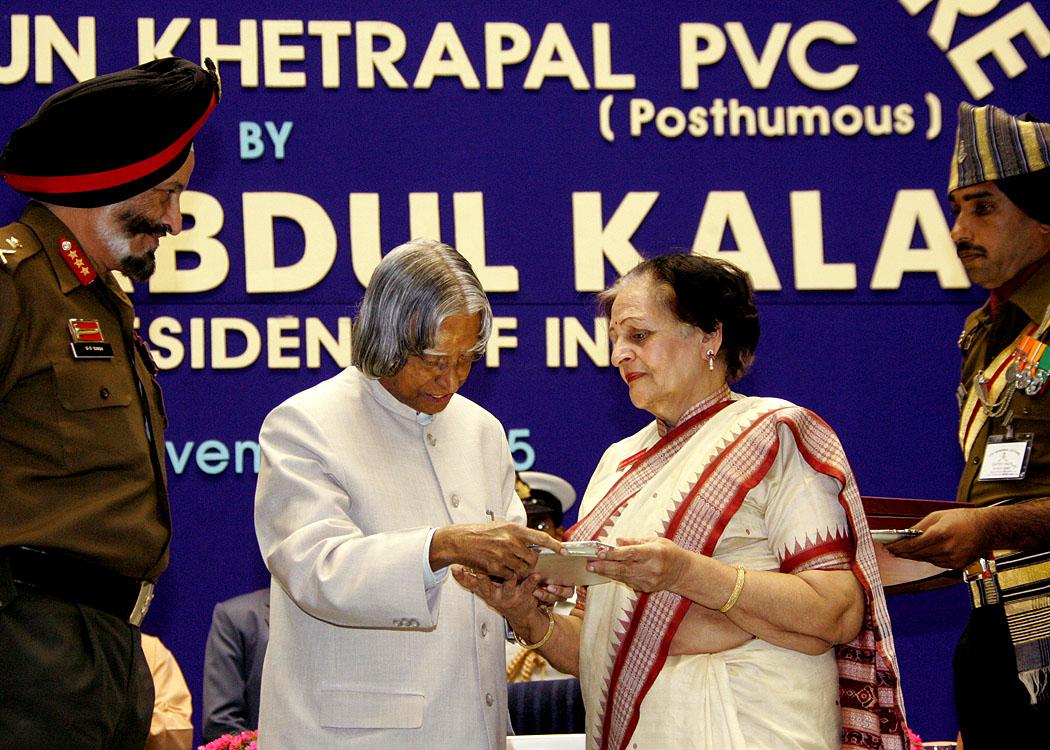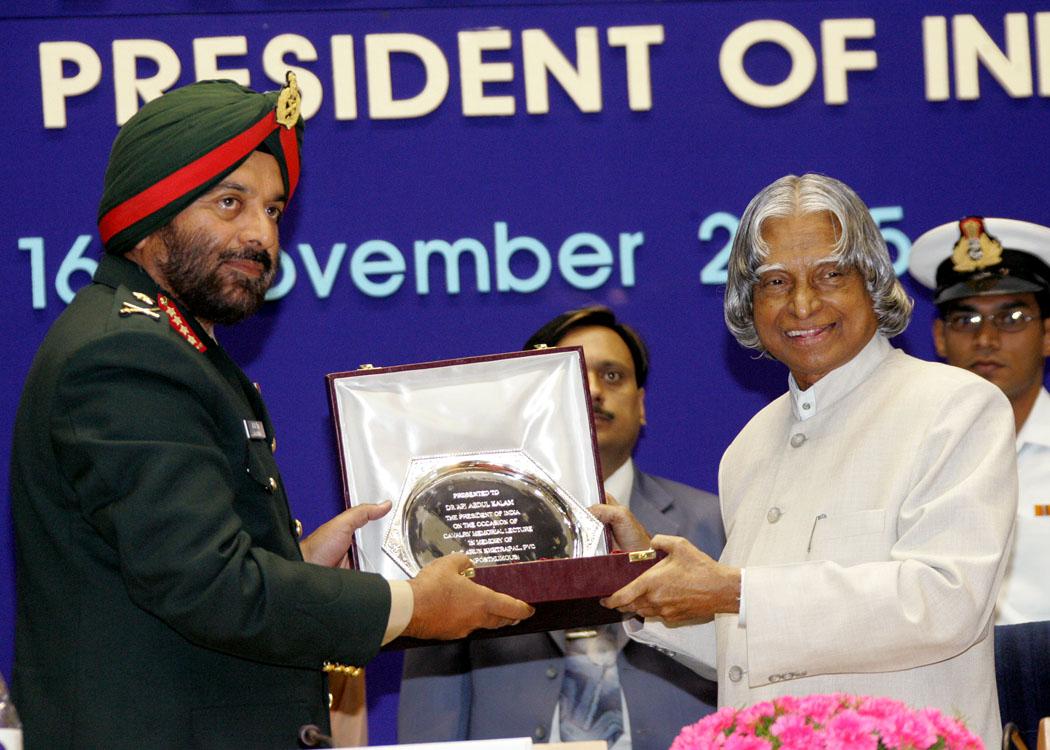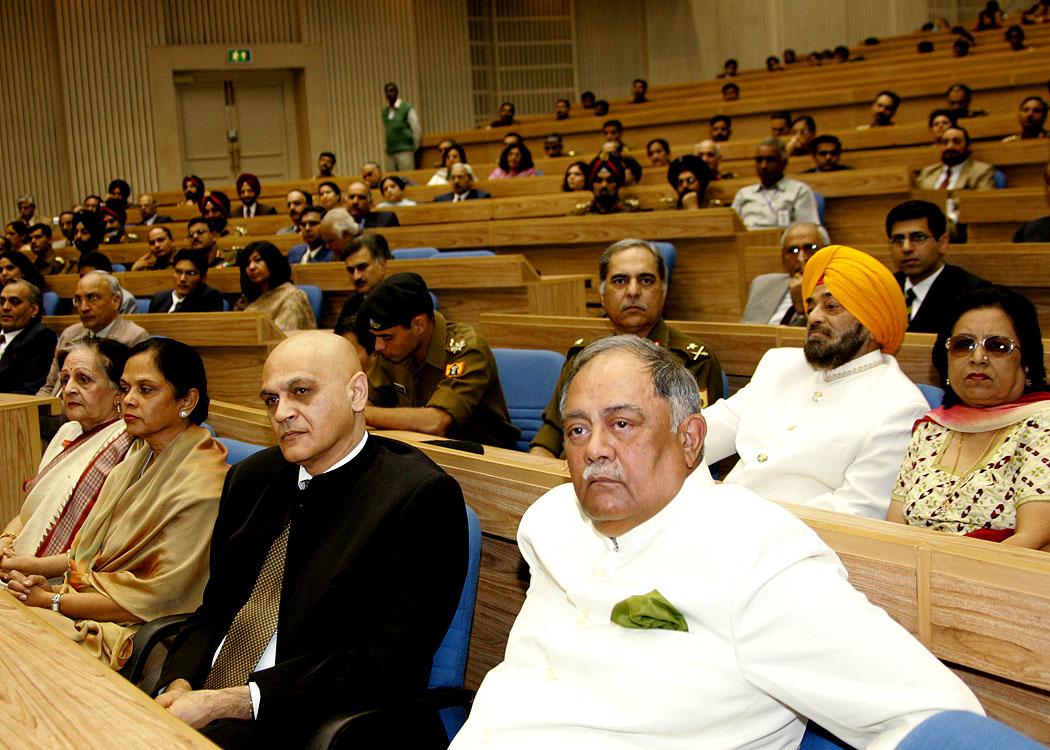Lecture In Memory Of Second Lieutenant Arun Khetarpal, Pvc, New Delhi
New Delhi : 16-11-2005
Courage led to the growth of Human Civilization
I am delighted to deliver the Cavalry Memorial Lecture which is dedicated to the memory of Second Lieutenant Arun Khetarpal, PVC of the Poona Horse, who laid down his life at the age of twenty while defending the motherland during the Indo-Pakistan war in 1971 in the Sakhagarh sector. I appreciate his supreme sacrifice and valour in the face of the enemy and his determination to hold his position gallantly without abandoning the post. He is definitely a role model for all the youth particularly the Officers, JCOs and Jawans serving in the Armed Forces. I greet the organizers, members of the Armed Forces and the students participating in this function. I recall on 15th August 2005 when I was paying the floral tribute at the Amar Jawan Jyoti with the chiefs of Armed Forces, let me share with you my feelings which I had, while saluting the courageous soldiers who fought for our nation.
Amar Jawan Jyot
Lights our heart with courage
Radiates to the nation, devotion
Spread the message of sacrifice
Ignites confidence upon our nation
Courage to defend the nation, courage to innovate, courage to invent and courage to overcome the sufferings and to succeed, are indeed the traits that led to the growth of human civilization. Let us remember the courageous acts and study certain events of our society on this occasion. I have selected the topic "Courage led to the growth of Human Civilization".
(A) The great human beings who symbolize courage towards injustice
Now I would like to describe the courage shown by Mahatma Gandhi when he was thrown out from a train in South Africa in 1893.
During my recent visit to South Africa in 2004, I boarded a train at Penrich railway station near Durban for a journey to Pietermartizburg, just tracing the footsteps of Mahatma Gandhi. It was from Durban station that Mahatma embarked on the fateful journey that in later years is regarded as having changed the course of his life. He boarded the train on 7th June, 1893 in order to travel to Pretoria, where he was due to meet legal clients. A first class seat was booked for him. The train reached Pietermaritzburg station at about 9.00 p.m. A white passenger entering the compartment could not stomach coloured person traveling with him. So he went out returned with two officials who ordered Gandhiji to move to the van compartment. Later, a white constable was called who took Gandhiji by hand and pushed him out of the train. His luggage was also taken out and the train continued its journey without him. Gandhiji spent the night in the waiting room. It was winter and the weather was bitterly cold. And although his overcoat was in the luggage, Gandhiji did not ask for it fearing further insults. Gandhiji contemplated returning to India but decided that such a course would be cowardice. He vowed to stay and fight the disease of racial prejudice. This changed the course of his life. Gandhiji even said: "my active non-violence began from that date'. The train and the compartments in which we traveled were exactly similar to the compartments in which Mahatma traveled. When I got down at the Pietermartizburg station, I saw the plaque in whose vicinity the Mahatma was thrown out. I went to the waiting room also where Mahatma spent the cold wintry night. The action of Mahatma Gandhi shows his courage when he was insulted by the white constable which later led to the birth of Ahimsa Dharma. This was the first movement in South Africa against racial discrimination. The people of South African remember the courageous action of Mahatma Gandhi and they are grateful nationally. Apartheid in South Africa at that time were indeed an experience for Mahatma Gandhi. It became for India?s freedom movement.
Now I would like to discuss the courage of a person who fought against the apartheid and succeeded.
(B)Courage to fight apartheid and virtue of forgiveness
While I visited South Africa in 2004, I also a great personality who was responsible for the freedom of South Africa. Particularly for the young people, you can learn two lessons. They are: Courage to fight against apartheid and virtue of forgiveness. Dr. Nelson Mandela is indeed an embodiment of these two traits.
In South Africa, Cape Town is famous for its Table Mountain; it has got three peaks called Table Peak, Devil Peak, and Fake Peak. Between the peaks it was a beautiful sight throughout the day, sometimes dark clouds and sometimes white clouds embracing the peaks. Table Mountain is very close to the sea coast of the Atlantic Ocean. We traveled by helicopter to Robben Island from Cape Town in 10 minutes flight. By fast powered boat it will take 30 minutes to reach the Robben Island. When we reached the Island, except sea roaring, the whole island, was a silent island symbolizing the thought: this is the place the freedom of individual was chained. We were received at the Island by Mr. Ahmed Kathrada a South African, who was a co-prisoner. What surprised me was this: can you imagine a tiny room, where sleeping and all human needs have to be fulfilled. It has to be remembered that Dr. Nelson Mandela, who was 6 feet tall was imprisoned in that room for 26 years ? fighting against the apartheid. The major part of his life was spent in this silent Island. He used to be taken for quarrying in the nearby mountain for a few hours in bright sun. This is the time his sight partially got damaged. In spite of his body being tortured, he revealed to the world the indomitable spirit in him. This is the time he evolved a manuscript of freedom in tiny letters every day, when the jail wardens went to sleep. This small tiny lettered manuscript finally became the famous book of Mandela "A long walk to freedom".
It was a great event for me to meet him in his house in Johannesburg. Dear friends, I would like to share with you, when I entered Dr. Nelson Mandela?s house, I saw his three dimensional form with cheerfulness: the mighty man who got the freedom for South Africa from the tyranny of apartheid. And also a person when he became the President of South Africa he gave the people freedom to move, freedom to live in South Africa to those people who specialized in apartheid and ill-treated and put him in jail for 26 years. Nelson Mandela accepted them as equals citizens who ill-treated them practicing apartheid. Dear friends, a big lesson that we learnt from this personality Dr. Nelson Mandela which is explained in one of the Thirukkurals, written 2200 years before.

which means, for those who do ill to you, the best punishment is returning good to them to make them feel their guilt.
Now I would like to discuss the courage shown by a lady who was virtually abandoned by her family.
(C) Courage to face social stigma
Recently, when I was in Bangalore, I addressed the members of CII attending the Leadership Conclave. There I asked two questions to be answered by every one of the participants. The two questions were (a) What I have learnt so far? (b) What I will be remembered for? I asked the members to correspond with me through email. One of the members in the Conclave was Smt. Asha Ramaiah.
Smt Asha Ramaiah, who is working as national advocacy officer for Indian Network for people Living with HIV/AIDS., who herself is a HIV/AIDS patient since 1995 gave touching answers to both these questions.
As an answer to the first question Smt Asha Ramaiah said,
"The true learning in my life began when I had to face the reality of my situation, when my husband's family turned me away from their home and later when my father told me to leave our house. I was like any other women who was allowed to flow with the currents of destiny. I learnt that I have to stand up to hold my precious life protected. At the first instance I had to stand up and face up life in awe, but thanks to the strength of my womanhood, which made the feeling of shock, a realization that my loved ones need support and I am responsible to take efforts to bring change in the lives of People Living with HIV/AIDS in India.
"I always felt that I had my opinions. But, when I have to face HIV, I realized the need to stand up and voice my opinion."
"Today with constant efforts that I made, and the support that received from my fellow people living with HIV, I received an acceptance in my community that even people of good standing come to me for an opinion, guidance and counseling on various personal issues. My parents are proud to share the testimony of my experience as a role model for others to follow. With a convinced family and a good peer support, I got remarried to another person living with HIV in 2000. He has given me ample support to work with my fellow people living with HIV for betterment of our lives."
"I learned when we had to decide upon having a child, how difficult it is for one to make decisions at the face of uncertainties; plunging in to the unknown that may have the risk to hold the responsibility of giving birth to an HIV positive child. We decided to follow the medical guidelines to reduce the risk. When we came victorious waiting for years and confirmed that our child has no infection, we learnt that, dreams come true only when you are ready to accept the responsibility of any possible risk in taking steps."
"Now we have the responsibility for planning the future of my child for the next 20 years. Our quality lifetime can be utilized for imparting our parental responsibility by ensuring him education, security and future. I also learned that I have the responsibility to share the message that all parents living with HIV/AIDS should take effort to access information and plan their children's healthy future."
For the second question What I will be remembered for? Smt Asha Ramaiah says,
"I will be remembered by the People Living with HIV/AIDS of many parts of the country and my family, relatives and associates for the courage, I showed to stand up and face life, and for my efforts in sharing the light I have acquired in the midst of struggle."
Friends, the message we get from the above experience of Smt Asha is that as human beings we may get into a problem. But we should not get defeated. We should find out ways of converting this very problem to our advantage through courage. Now I would like to discuss the courage of three of my friends who are fighting cancer valiantly.
Warriors of Indomitable Spirit
The first one is a technologist, second one is an author and the third one is a painter, all three are handling their blood cancers with courage. Undaunted by the presence of a disease of poor morbidity in their bodies they are relentlessly pursuing the mission of life. The technologist-industrialist who is suffering from cancer for 20 years says, like a gladiator, he says he will defeat his cancerous cells. He is continuously contributing technologically and innovating for his industry. Every year he is publishing a book on me and releasing it on my birthday for the last three years. The second courageous personality is a biographer and he has written many books on people. He named the recent book as "Celebration of cells" that narrates the indomitable spirit of the personality. The third courageous personality is a painter whom I invited to stay in the Rashtrapati Bhavan. He created beautiful paintings capturing the beauty and life in Mughal Garden. He showed me a painting which was most beautiful and he said the paintings was his best. I asked him how it got evolved. He said when he went through chemotherapy at the Tata Memorial Hospital, the pain was very heavy during the process of chemotherapy. The painting got evolved out of the pain and he said during the process of painting he got great relief from the pain.
The message of these three friends of mine is sthat cancer can be defeated through courage, medical treatment and blessings of the Almighty.
Now let us discuss the scientific contribution of Madame Curie with courage and determination.
Madame Curie
Madame Curie was born to Maria Sklodowski in Warsaw, Poland in 1867, the youngest of five children. When she was born, Poland was controlled by Russia. Her parents were teachers, and she learned at an early age the importance of education.
Her mother died when she was young, and when her father was caught teaching Polish - which had been made illegal under the Russian government. Manya, as she was called, and her sisters had to get jobs. After a couple of failed jobs, Manya became a tutor to a family in the countryside outside Warsaw. She enjoyed her time there, and was able to send her father money to help support him, and also send some money to her sister Bronya in Paris who was studying medicine.
Bronya eventually married another medical student and they set up practice in Paris. The couple invited Manya to live with them and study at the Sorbonne - a famous Parisian University. In order to fit in better at the school, Manya changed her name to the French "Marie." Marie studied physics and mathematics and quickly received her masters' degrees in both subjects. She remained in Paris after graduation and started research on magnetism.
For the research she wanted to do, she needed more space than her small lab. A friend introduced her to another young scientist, Pierre Curie, who had some extra room. Not only did Marie move her equipment into his lab, Marie and Pierre fell in love and married.
A friend of the Curies, A. Henri Becquerel, had been playing with recently discovered properties of the element uranium. He talked to Pierre and Marie about those properties and they became interested in them too. Marie Curie set about investigating the effect, which she named "radio-activity" for her Doctorate research.
Marie Curie checked many other elements to determine whether they too were radioactive. She found one, thorium, and also came across a source of radiation in a mixture called "pitch-blend," which was much more powerful than either thorium or uranium.
Working together, it took Marie and Pierre four years to isolate the radioactive source in the pitch-blend. Marie named it radium. For the discovery of radium, Marie and Pierre won a Nobel Prize in Physics in 1903, which they shared with their friend A. Henri Becquerel. Shortly, Marie found that what she had discovered was not pure radium, but she was able to isolate the element itself after quite a struggle. For this work, she was given the Nobel Prize for Chemistry in 1911.
During her work, Marie discovered radiation could kill human cells. She reasoned that if it could kill healthy human cells, it could kill diseased human cells and went about isolating radium for use in killing tumors.
In 1906 Pierre Curie was offered the position of director of the Physics Laboratory at the Sorbonne. Before he could take the position, however, he was run over by a carriage and killed. After her husband died, Marie was offered and took the position, the first woman to become director of a research laboratory.
During the first World War, Marie Curie went to work for the French designing and building X-ray machines. Knowing that moving soldiers to a hospital before they needed surgery was not always possible, she designed the first mobile X-ray machine and traveled with it along the front lines during the war.
On July 4, 1934, Marie Curie died in Paris, killed by her own experiments. She died of radiation poisoning and may have been the first person to do so. Marie Curie had brought herself up from poverty, struggling to get her education and succeeding brilliantly. The work she did, she did with patience, often getting results only after years of careful experimentation, while struggling for money to support her work. For her struggles, she received two Nobel Prizes - the first woman to win even one. Through the knowledge she gained, thousands of lives have been saved. The courage and perseverance shown by Madame Curie in her pursuit of scientific mission and achieving successes are indeed remarkable and stimulating.
Conclusion: Indomitable spirit
So far we have come across a large number of courageous people and their contribution to society. One of the important qualities all of them posses is Indomitable Spirit. Let us study the characteristics of indomitable spirit. It has two components. The first component is that there must be a Vision leading to higher goals of achievement. I would like to recall a couplet from Thirukkural by the Poet Saint Thiruvalluvar written 2500 years ago.
Quote:

It means that whatever may be the depth of the river or lake or pond, whatever may be the condition of the water, the Lilly flower always comes out and blossoms. Similarly, if there is a definite determination to achieve a goal even if it is impossible to achieve, the man succeeds.
Many of us have gone through large programmes and projects. We would have experienced that success is not in sight and there are many hurdles. The same poet reminds us at this point of time through another couplet:

We should never be defeated by any problems. We should become master of the situation and defeat the problems. This is the second component of Indomitable Spirit. I consider these two Thirukkurals characterize the indomitable spirit. Indomitable Spirit indeed led to the growth of civilizations for many centuries.
My best wishes to all the participants of this programme to have the courage, perseverance and determination to face the challenges of life and succeed in their missions with Indomitable Spirit.
May God bless you.



